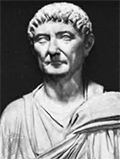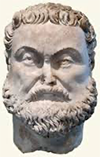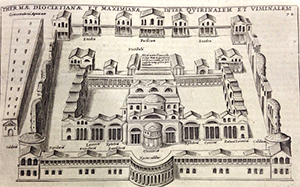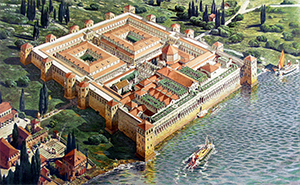Diocletian was Emperor of Rome in the 3rd Century. Known for his military successes and his governmental and military reforms, he is perhaps most well-known for his Tetrarchy, which with he attempted to ensure a steady and proper imperial succession.

He was born on Dec. 22, 245, in Dalmatia. His name at birth was Diocles. Not much is known of the first few decades of his life.
He rose to prominence in the army, serving in Illyria and Moesia; he went to Persia in 283 with the emperor Carus, as part of the imperial bodyguard, and served Carus's son, Numerian, in the same capacity. When the new emperor died after just a short time, Diocles killed Numerian's father-in-law, who was the commander of the Praetorian Guard and had harbored dreams of ruling as his successor. Diocles gained proclamation as emperor and then defeated Numerian's co-emperor, Carinus, at the Battle of River Margus. After this victory, the man in sole control of the Roman throne took the name Gaius Aurelius Valerius Diocletian.
Diocletian had studied geography and history and thought that the Empire as it stood in the late 3rd Century was too large for one  man to rule effectively. In November 285, he named his son-in-law, Maximian, as commander of the Empire in the West. Diocletian kept power in the East and ostensibly ruled the West as well because he retained for himself veto power over any decisions made by Maximian.
man to rule effectively. In November 285, he named his son-in-law, Maximian, as commander of the Empire in the West. Diocletian kept power in the East and ostensibly ruled the West as well because he retained for himself veto power over any decisions made by Maximian.
The two leaders agreed on the direction that the Empire should take and were content operating in their separate spheres. It marked a peaceful change from the several dozens of military anarchy through which the people of the Roman had lived. In the previous 50 years alone, a full 26 had sat on the throne; much of the trouble had arisen from a lack of a strong ruler and/or a known and capable successor.
The Western commander had his hands full with a rebellion led by Carausius, the commander of the North Sea fleet, who seized control of the forces in Britain and part of Gaul and proclaimed himself emperor. Maximian issued a death warrant for the rebellious commander, and Carausis's own finance minister, Allectus, collected. Diocletian was active in wars in the East for the next few years, turning back challenges in Moesia and Pannonia and then in Persia, defeating the Sarmatians and Saracens.

Constantius |

Galerius |
Thinking ahead to the tricky element of succession, Diocletian created a four-man head of government scheme that, with its two tiers of two rulers each, should, he thought, ensure a smooth transition from one ruler to the next. This new plan named Diocletian and Maximian as Augusti. Each of them would have a Caesar under them, as second-in-command, designated to succeed whichever Augustus he reported to, in the event of the top man's death. Maximian chose as his Caesar his Praetorian commander Constantius, whom he also adopted. For his Caesar, Diocletian chose Galerius. The four men divided the Empire between them:
- Diocletian controlled the East and had headquarters at Nicomedia.
- Maximian controlled the West and had headquarters in Milan.
- Constantius ruled in Britain and Gaul.
- Galerius ruled in the Balkans.
This tetrarchy generally did what it was supposed to do, with each of the four men ruling over one-quarter of the Empire and having authority to put down rebellions, such as the one that Galerius dealt with in Egypt in 291–293.
Diocletian also had success in bringing fresh ideas to much of the rest of the empire, including a large-scale change in provincial boundaries: He doubled the number of provinces, from 50 to 100. Ruling over these provinces were a number of vicars who had no military intent. In the army realm, he created legions based on the frontiers, to be able to react more quickly to incursions by troublesome Germans and other neighbors, and mobile legions that were stationed in garrison cities but could move out at a moment's notice to reinforce other forces where needed.

He ordered a new census and revised the tax system. With some of the new income, he funded a new baths in Rome, the largest in the world; it was completed in 305. One of his proclamations, the Edict of Maximum Prices, froze both wages and the prices of goods and services, in an attempt to stop runaway inflation. This edict proved difficult to enforce across the breadth of the Empire.
In his later years, Diocletian began to think of himself as a living god and demanded that anyone wishing to see him bow before him and then kiss his purple robe. He looked the part by sitting on an elevated throne. Whether intentionally or not, he targeted Christian soldiers and government officials by demanding that all members of both organizations sacrifice to the Roman gods and that anyone refusing to do so would be forced to leave their post. He intentionally targeted Christians in 303 with a directive to destroy Christian churches and writings. The combination of these two things resulted in a large-scale persecution of Christian people within the Empire.

In 303, Diocletian visited Rome (the only time he ever went there). He fell ill and abdicated, in 305, retiring to a very large fortress in Spalatum, in what is now Croatia. He convinced Maximian to abdicate as well, and the tetrarchy swung into action: Constantius and Galerius moved up to being Augusti, and the new Caesars were Maximinus and Severus.
Diocletian had one brief return to the political scene, in 308, to settle differences at a peace conference, but refrained from further action after that. He died in his palace on Dec. 3, 312.